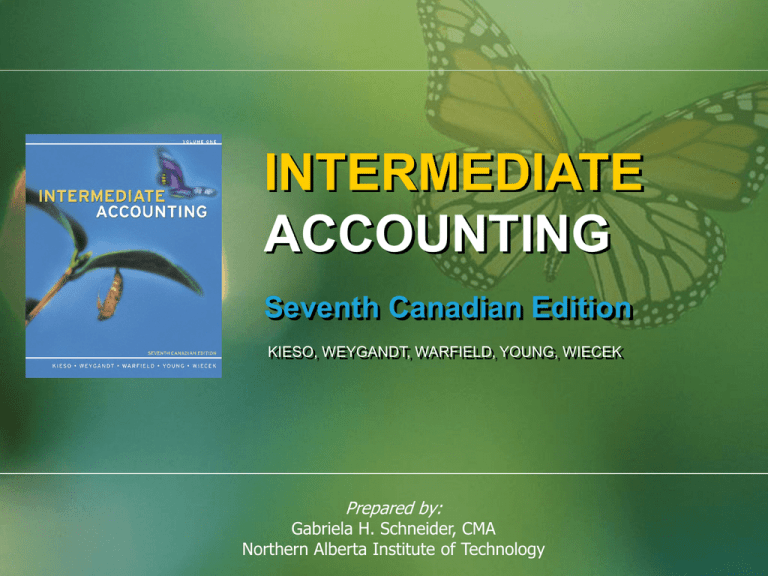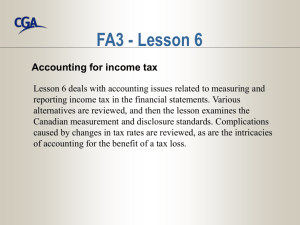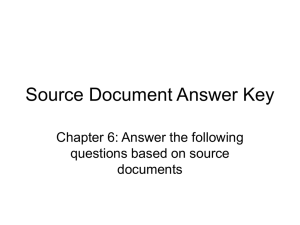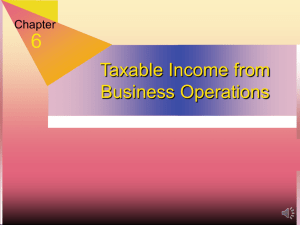
INTERMEDIATE
ACCOUNTING
Seventh Canadian Edition
KIESO, WEYGANDT, WARFIELD, YOUNG, WIECEK
Prepared by:
Gabriela H. Schneider, CMA
Northern Alberta Institute of Technology
CHAPTER
19
Income Taxes
Learning Objectives
1. Explain the difference between accounting
income and taxable income.
2. Explain what a taxable temporary difference is
and why a future tax liability is recognized.
3. Explain what a deductible temporary difference
is and why a future tax asset is recognized.
4. Differentiate among timing, temporary, and
permanent differences.
Learning Objectives
5. Prepare analyses and related journal entries to
record income tax expense when there are
multiple temporary differences.
6. Explain the effect of various tax rates and tax
rate changes on future income tax accounts.
7. Apply accounting procedures for a tax loss
carryback.
8. Apply accounting procedures and disclosure
requirements for a tax loss carryforward.
Learning Objectives
9. Explain why the future income tax asset account is
reassessed at the balance sheet date.
10. Explain the need for and be able to apply
intraperiod tax allocation.
11. Identify the reporting and disclosure requirements
for corporate income taxes.
12. Describe the differential reporting option for
income taxes.
13. Describe the key aspects of the asset-liability
method, and identify outstanding issues with this
approach.
Accounting for Income Taxes
Income Tax
Fundamentals
Accounting income
and taxable income
Future taxable
amounts and future
taxes
Income Tax Loss Intraperiod TaxFinancial
Carryover Benefits Allocation
Statement
Objective
Presentation
Introduction
Loss carryback
illustrated
Balance sheet
presentation
Loss carryforward
illustrated
Income
statement
presentation
Future deductible
amounts and future
taxes
Carryforward with
valuation
allowance
Calculation of
taxable income
Review of future
tax asset
Tax rate
considerations
The AssetLiability
Method
Other
disclosures
Perspectives
Differential
Reporting
Review and
some
conceptual
questions
Comprehensi
ve Illustration
Fundamentals
Accounting income (per GAAP) ≠ Taxable
income (per Income Tax Act)
Accounting income → Income tax expense
Taxable income → Income tax payable
Income tax expense ≠ Income tax payable
Fundamentals
To determine income taxes payable:
Accounting income
± differences
= Taxable income
Taxable income × tax rate = taxes payable
Fundamentals
Same revenue and expenses usually included
in income statement and in taxable income,
but….
….often in different accounting periods
Fundamentals
-
-
-
If expense deducted in Year 1’s accounting
income, and Year 2’s taxable income:
Year 1’s taxable income is higher than Year
1’s accounting income
The expense is deductible for tax purposes in
the future
At end Year 1, company has a future
deductible amount
Future deductible amount x tax rate = future
income tax asset
Fundamentals
-
-
-
If expense deducted in Year 1’s taxable
income, but Year 2’s accounting income:
Year 1’s taxable income is lower than Year 1’s
accounting income
The expense will have to be added in
calculating taxable income in the future
At end Year 1, company has a future taxable
amount
Future taxable amount x tax rate = future
income tax liability
Fundamentals
Also…
Future tax assets and future tax liabilities also
arise from revenue being reported in different
accounting periods for income statement and
tax purposes.
Future Tax Asset and
Future Tax Liability - Sources
• Future taxes may be a:
– Future tax liability, or
– Future tax asset
• Future tax liability arises due to net taxable
amounts in the future
• Future tax asset arises due to net deductible
amounts in the future
Future Tax Liability Example
Chelsea Inc. - 2005
Accounting
Revenue
Tax
$130,000
$100,000
60,000
60,000
Income
$ 70,000
$ 40,000
Tax @ 40%
$ 28,000
$ 16,000
Expenses
Recording Future Tax Liability –
Example - 2005
• Income tax expense =
• Income tax liability
=
$28,000
$16,000
• Journal Entry:
Income Tax Expense
Future Tax Liability
Tax Payable
28,000
4,000
16,000
Future Tax Liability Example
(Cont’d) Chelsea Inc. - 2006
Accounting
Revenue
Tax
$130,000
$150,000
60,000
60,000
Income
$ 70,000
$ 90,000
Tax @ 40%
$ 28,000
$ 36,000
Expenses
Recording Future Tax Liability –
Example - 2006
• Income tax expense =
• Income tax liability =
$28,000
$36,000
• Journal Entry:
Income Tax Expense 28,000
Future Tax Liability
8,000
Tax Payable
36,000
• Assuming there are no other differences the
future tax liability will reduce to a zero
balance.
Future Tax Liability
Is it a Liability?
•
•
Sometimes dismissed by analysts
Meets CICA Handbook, Section 1000
definition of a liability:
1. Results from a past transaction
2. It is a present obligation
3. It represents a future sacrifice
Future Tax Asset Example
Cunningham Inc. - 2005
Books
Warranty expense
deducted, 2005
Tax rate = 40%
Income reported
in 2005
Income tax exp.
Income tax pay.
500,000
Tax
0
1,000,000 1,500,000
400,000
600,000
Recording Future Tax Asset –
e.g. Cunningham Inc. -2005
Journal Entry:
Income Tax Exp.
Future income tax asset
Income Tax Payable
400,000
200,000
600,000
Future Tax Asset
In subsequent years:
- warranty exp. of 500,000 deducted for tax,
but not for books
- Income taxes payable reduced by 500,000 ×
40% = 200,000
- Entry in future, therefore:
Income tax expense
$x
Future income tax asset
$ 200,000
Income taxes payable
$x − 200,000
Future Tax Asset
Is it an Asset?
•
Meets all necessary criteria from CICA
Handbook, Section 1000:
1. It will contribute to future net cash flows
2. Access to benefits are controlled by the
entity
3. It results from a past transaction or event
Permanent, Timing, and
Temporary Differences
• Taxable income is determined by starting with
accounting income and adjusting it for
permanent and timing differences in the year
• The accounting for future tax liabilities and
future tax assets is based on the tax impact of
the accumulated timing differences =
temporary differences
Permanent Differences Examples
• Items, recognized on income statement, but
never for income tax purposes:
• Non-tax-deductible expenses (fines, expenses
relating to non-taxable revenue)
• Dividends from taxable Canadian corporations
• Items, recognized for tax purposes, but not for
financial accounting purposes:
• Depletion allowance of natural resources in
excess of cost
Summary of Permanent
Differences
Sources of PERMANENT DIFFERENCES
Some items
are recorded
in books
but never
on tax return
Other items
are never
recorded in books
but recorded
on tax return
No future tax effects
for permanent differences
Timing Differences
• Are treated the same for books and tax—but in
different periods.
• Relate to income statement differences
• Cause the balance of a temporary difference to
change from period to period
• Originating timing difference
– Cause of the initial difference
• Reversing timing difference
– Causes a temporary difference to decrease
Temporary Differences
• = accumulated timing differences
• = difference between book value of an asset
or liability and its tax value
• Is either a deductible temporary difference
(i.e. will be deducted from accounting income
in calculating taxable income in the future) –
giving rise to a future tax asset, OR
Temporary Differences
• …a taxable temporary difference (i.e. will be
added to accounting income in calculating
taxable income in the future) – giving rise to a
future tax liability.
Temporary Differences Examples
Property, plant, and equipment:
Net book value (NBV)
Tax value (Undepreciated
capital cost, UCC)
Taxable temporary difference
If tax rate is 30%, future tax
liability = 6,500 × 30%
= 43,500
= 37,000
= 6,500
= 1,950
Temporary Differences –
Examples (cont’d)
• Estimated warranty liability:
NBV
= 3,000
Tax value
=
0
Therefore, deductible
temporary difference
= 3,000
If the tax rate is 30%,
future tax asset = 3,000 × 30% = 900
Exercise 19-1: Temporary and
Permanent Differences
a) A timing difference that will result in future
deductible amounts, and therefore, will
usually give rise to a future income tax
asset
b) A timing difference that will result in future
taxable amounts and, therefore, will usually
give rise to a future income tax liability
c) A permanent difference
Exercise 19-1: Temporary and
Permanent Differences
1.
2.
3.
4.
5.
CCA is used for tax purposes, and straight-line
amortization used for financial reporting purposes.
A 20% rate used for both. Assume no ½ year rule.
A landlord collects rents in advance. Rents are
taxable in the period received.
Non-deductible expenses are incurred in obtaining
tax-exempt income.
Costs of guarantees and warranties are estimated
and accrued for financial reporting purposes.
Installment sales are accounted for by the accrual
method for financial reporting purposes and cash
basis for tax purposes
Exercise 19-1: Temporary and
Permanent Differences
6.
For some assets, straight-line amortization is used for both
financial reporting and tax purposes, but assets’ lives shorter
for tax purposes.
7. Pension expense reported on the income statement before it
is funded. Pension costs are deductible only when funded.
8. Proceeds received from life insurance on the death of a key
officer.
9. Tax return reports no revenue from dividends received from
taxable Canadian corps. They are reported as investment
income on the income statement.
10. Estimated losses on pending lawsuits accrued for financial
reporting purposes. The losses are tax deductible in the
period when the related liabilities are settled.
Exercise 19-1: Temporary and
Permanent Differences
1.
2.
3.
4.
5.
(b)
(a)
(c)
(a)
(b)
6. (b)
7. (a)
8. (c)
9. (c)
10. (a)
Income Tax Expense
= total of current tax expense (benefit) and
future tax expense (benefit)
Current income tax expense (benefit)
= income taxes payable/receivable, based on
taxable income for current year
Income Tax Expense (cont’d)
Future income tax expense (benefit)
= amount of adjustment needed to the future
income tax asset/liability account on the
balance sheet
Future Tax Expense: Example
Example 1:
Future tax asset before adjustment 1,000 dr.
Correct balance determined to be 2,400 dr.
Entry:
Future income tax asset
Future income tax benefit
1,400
1,400
Future Tax Expense: Example
Example 2:
Future tax asset before adjustment 1,000 dr.
Correct balance determined to be
200 dr.
Entry:
Future income tax expense
Future income tax asset
800
800
Future Tax Rates
• CICA Handbook, Section 3465
• The effect of future tax rate changes should
be immediately recognized on all future tax
accounts
• Treated as an adjustment to the future
income tax expense/benefit
Future Taxes – Final Notes
• Use separate accounts, but remember to report the
net effects
• A future tax asset or liability is classified as long-term if
the item which originated or caused the future tax
amount is long-term
• Future tax amounts have no impact on current income
tax expense
• On the income statement, report current income tax
expense/benefit separately from future income tax
expense/benefit
• The Future Income Tax Asset account is periodically
reassessed to ensure realizable
Tax Loss Carryback and
Carryforward
• The amount reported is the tax calculated
from the loss
• May be carried back three years, or forward
for the next seven years
• When applying the carry back, always apply
to the oldest available year first
• The benefit of a tax loss carryforward is
recorded (i.e. booked) if it is more likely than
not that taxable income will be earned in
future periods to apply it against
Tax Loss Carryback
• Reopen prior year’s tax returns, reduce prior
taxable incomes with current year’s loss
Claim back taxes previously paid:
Income taxes receivable xx
Current income tax benefit xx
If loss still remains, carry it forward
Tax Loss Carryforward
Can you recognize (book) the tax benefit of a
loss carryforward?
It depends...
…if more likely than not that benefit will be
realized (i.e. co. will generate taxable income in
the future to apply loss against), then recognize
tax benefit as an asset:
Tax Loss Carryforward (Cont’d)
Future income tax asset xx
Future income tax benefit
xx
…if not more likely than not that benefit will be
realized, then – NO – just report existence of
loss carryforward in notes to the financial
statements.
Tax Loss Carryforward (Cont’d)
If benefit recognized as a Future Tax Asset,
when co. applies the losses against taxable
income in the future:
Future income tax expense xx
Future income tax asset
xx
Tax Loss Carryforward (Cont’d)
If benefit not “booked” and company does
generate taxable income in the future and
uses the unrecognized losses to reduce
taxable income:
Income tax payable
xx
Current income tax benefit* xx
* Due to realization of unrecognized loss
carryforward
Intraperiod Tax Allocation
• Income tax expense is reported with its
related item, such as discontinued
operations, extraordinary item, error
correction in RE, etc.
• Intraperiod Tax Allocation
– Tax expense is allocated within the financial
statements of the current period
• Interperiod Tax Allocation
– Tax expense is allocated between years
Differential Reporting
• Available to organizations that
– Are non publicly accountable
– Owners have unanimously consented
• Income tax reporting follows the taxes
payable basis:
Income tax expense = taxes currently
payable
The Asset-Liability Method
• Asset-liability method objectives
– Recognize taxes payable (refundable)
amount for the current year
– Recognize future tax liabilities or assets for
events (transactions) that have been
included in the current year’s financial
statements or tax returns
• Basic principles to achieve these
objectives
Basic Principles of Accounting
for Income Tax
1.
2.
3.
4.
Current tax liability or asset is based on current
year’s taxes payable (or refundable) and is
recognized in the current year
A future tax liability or asset is recognized for
future tax effects of temporary differences and
carryforwards
Measurement of current and future tax liabilities
and assets is based on the tax rate expected at
the time the liability will be settled or asset
realized
Future tax asset is reduced by any tax benefits
not expected to be realized
COPYRIGHT
Copyright © 2005 John Wiley & Sons Canada, Ltd.
All rights reserved. Reproduction or translation of
this work beyond that permitted by Access Copyright
(The Canadian Copyright Licensing Agency) is
unlawful. Requests for further information should be
addressed to the Permissions Department, John
Wiley & Sons Canada, Ltd. The purchaser may make
back-up copies for his or her own use only and not
for distribution or resale. The author and the
publisher assume no responsibility for errors,
omissions, or damages caused by the use of these
programs or from the use of the information
contained herein.






